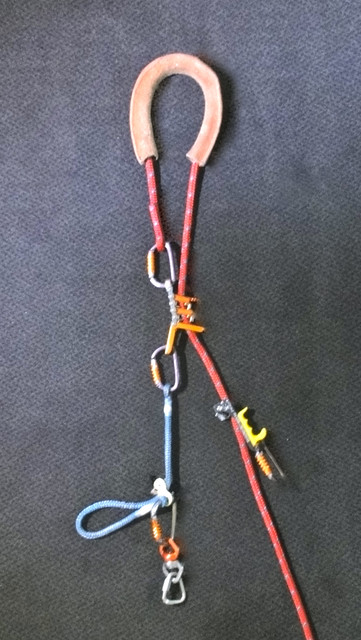I have to be critical of my own system, so will be of others.
Yours is a 2:1 system, with the complete set of disadvantages pointed out in past pages that apply to 2:1 systems in general.
I've seen complicated, multi-piece systems, but yours may be a new champion in the arena of
sheer number of pieces within a single system.
I don't doubt this system works well and does what you want it to do, and compared to a friction hitch system your performance may be better, but you are still limited in the sense of the limitations imposed by a 2:1 system + the time costs of setting and retrieving the friction saver + the time costs just setting up the system prior to the ascent and breakdown after descent.
The actual function of the system may be simple and uncomplicated to use. However, the overall set-up, and the
sheer number of individual pieces makes this rather complicated in an overall sense.
The Futura, allowing you to get a longer pull, still flies in the face of a 1:1 system where your 'pull' is half that of a 2:1 system to begin with. You still hoist yourself with twice the motion, as opposed to propelling yourself upward with half the motion.
A positive I note is very little loss of purchase in your system, as you would have with a collapse/elongation of a hitch. Clean.
Just pull on the tail of the rope and the Unicender captures your progress.
Yes, that's exactly what I mean. Your major losses (besides the 2:1 issue) would be saddle sit-back losses, but that's another subject.
The yellow Kong "futura" single handed ascender replaces the rather bulky dual ascender.
The Futura replaces a larger single ascender. In this system, you would not be using a dual ascender. If you had a dual ascender, you would not be using this system. You don't specify a
dual handled dual ascender or a
single handled dual ascender, the former being quite a bit bulkier than the latter.
One of the goals that's been proposed is creating a system that will allow you to climb 1:1 SRT, 1:1 twin or 2:1 doubled. Yours is set up to do 2:1 doubled only.
For what it IS, your deserves applause. For what it DOES, it gets thrown on the stack of the many dozens of setups already out there for 2:1 systems. I would rate yours as new school 2:1, but 2:1 nonetheless. The advantages appear to be somewhat over that of a friction hitch setup, but enough gain, apparently, that you've gone to the extra effort of setting up "Complicated rigging for simplicity of operation." I believe there can be simple rigging with simplicity of operation, one that allows
all three rope techniques to be incorporated at will.
I very much appreciate the effort invested in creating this, and it looks like it would be smooth. I have not seen a setup quite like this, kudos to you for pushing the creative envelope, and thank you for sharing.





